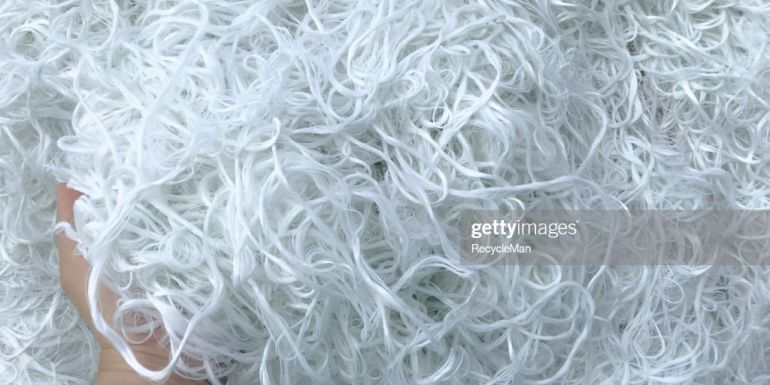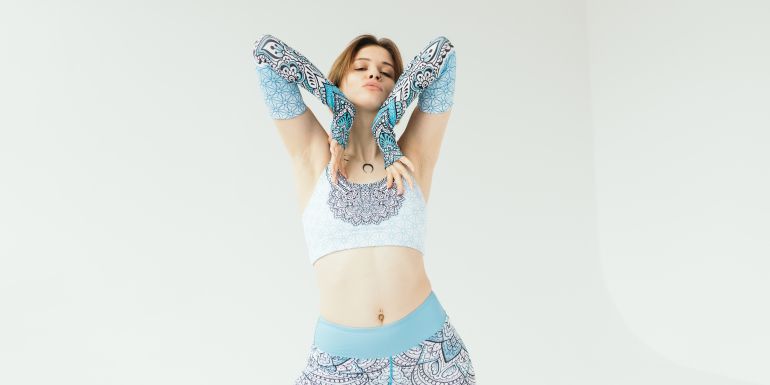Most of us appreciate clothes made of natural materials such as cotton, linen, silk. We value them for the comfort of wearing them and most often for the fact that they are made of natural ingredients. We are convinced by the fact that they transmit air because they are airy. So how in this love for natural fabrics can you convince yourself to polyester?
And is it worth it to like this jersey and accept it in some clothes worn every day even a little?
The division of fabrics, a few things worth to know about
The division of materials, although not complicated, causes problems and can be controversial among customers. The names on the labels often tell us nothing. So it is worth knowing the basic information that the fibres from which our clothes are made are divided into: natural and chemical. Natural again for those of plant origin: cotton, linen, bamboo, coconut and ramie fibres; and those of animal origin, such as silk and wool. Chemical ones are divided into artificial ones: viscose, modal, acetate, lyocell/tencel, which are made of cellulose from trees; and synthetic, such as: polyester, polyamide, acrylic, polyacrylic, elastane, nylon, produced from petroleum.

Which material wins in production?
To make it more complete, the question should be supplemented with the intended use of the material. After all, different needs can be satisfied by gauzy silk, and others by sports polyamide. However, apart from this issue, it is safe to say that the production of all fibres, whether natural or synthetic, is not without significance for our environment.
During growing cotton are used large amounts of chemicals, pesticides, insecticides, which have an impact on the condition of the soil and the presence of various living organisms in a given area. For example the production of one cotton T-shirt requires about 2,700 litres of water. This is around how much the average person drinks in 3 years. A much better choice on this score seems to be organic cotton, for which no chemicals are used, and water consumption is more limited.
Still, the impact on the availability of water in a given area is huge, both for people and animals. Much more energy is used in the production of polyester, e.g. in the form of consumption of wood or oil, which contributes to global warming with greenhouse gases.
So why polyester?
Like each material, polyester also has its pros and cons.
Contrary to popular opinion, nowadays polyester is no longer the same material that our mothers and grandmothers used. The production technology, many years of practical testing, and thus the introduction of innovative solutions, allowed for the production of a fabric that is able to meet the most demanding requirements. Of course, you can still come across low-quality polyester on the market, but we will not mention such a material here, because we do not use such a raw material in the production of our clothing.

Advantages
Polyester is an extremely durable material, it can be flexible in itself, but with the addition of elastane it becomes even more susceptible to stretching, and then returns to its previous shape and form.
Does not absorb water. But it also does not stop it. Thanks to many years of improvements, it wicks sweat from the human body to the outside, which many manufacturers (including us) use to promote their clothes. It also has another advantage - it dries quickly. It does not absorb moisture from the environment, so the drying time is often shortened to one or two hours (sometimes even shorter). The lack of absorbency gives us another advantage, which is resistance to stains. You have to try really hard to stain clothes made of polyester. Another advantage is that it practically does not crease at all and is also very light.
Thanks to these two factors, we do not have to worry about the size of our luggage when going on a trip, because firstly we do not bother with the iron, secondly we can take many pieces of clothing, leggings, shirts or underwear, without any special limitations.
What is important, polyester is resistant to moulds, moths and fungi and therefore we can be sure that our clothes will not be affected by any microorganisms.
Disadvantages
The first disadvantage with which we can associate clothes made of polyester is that they electrify. In addition, it happens that clothes made of polyester do not let moisture out, and this causes an unpleasant odour on both the material and the skin.
Polyester is not hygroscopic like cotton or linen. It does not absorb moisture, it can only let it out. This can be a disadvantage, but also an advantage. Thanks to the fact that it does not absorb water itself, you do not feel the discomfort of wet clothes.
Knowing all the disadvantages listed above, we were looking for a solution to eliminate them for the production of our clothes. Fortunately, the technology of producing sports polyester materials is currently extremely advanced and offers ready-made solutions so that the clothes meet the requirements of the most demanding clothing manufacturers and their customers. We chose a jersey that, in addition to the above-mentioned advantages, also has antibacterial properties and prevents the formation of unpleasant odours on it. This material is highly technologically improved, thanks to which it does not electrify and additionally has a protective coating against UV rays.
Recycling
As we have already mentioned, the production of clothing materials is associated with a huge consumption of both water and energy, as well as the use of large tracts of land. In recent years, the solution to this has been the processing of materials. Polyester is one of those materials that is easily used to produce new high-quality fibres. Polyester is 100% recyclable and reusable. It consumes much less energy than in the production of new materials, and also closes the supply chain. We also use recycled knitwear in Second You. We pay attention to where and under what conditions the material was produced and whenever possible, we reach for the one that, on the one hand, meets our expectations in terms of flexibility and strength, and on the other hand meets the visual and tactile requirements.
Recycling and what else?
We are big fans of recycling, but even bigger of making smart decisions when shopping. Do we have to buy a few, a dozen or even several dozen pieces of new clothes a year? Do we have to change these clothes every season? If so, have we ever wondered why? Is it a matter of changing fashion, or maybe our taste, or maybe the clothes we buy are made of poor quality materials that just look bad after the first or second wash? If it is a matter of fashion and material consumption, we are here to help. As for taste, well… there is no arguing with tastes. We respect individual choices and we are inspired by many of them. Considering fashion, we assure you that Second You leggings newer go out of style. Some styles go, others come, and our leggings are original enough not to undergo these changes, remaining in the centre of attention regardless of passing trends. However, the most important thing is that the clothes we produce are of such high quality that it takes many seasons for them to show wear. Simply, the materials from which we sew our clothes are extremely durable, which we are really proud of!

What kinds of clothes?
Polyester is very often used in the production of sportswear. As we mentioned earlier, it is widely used for its technical properties, including breathability and easy drying. It is also used to produce thermoactive underwear, everyday underwear, swimsuits and shorts, outerwear, as well as many others, e.g. dresses and skirts.
Sports clothes, due to the specificity of use, require special materials that will meet many requirements of both professional and amateur athletes. Many people want their clothes not to be wrinkled or pulled out in crucial places, such as buttocks or knees, despite movements. The weight of each piece of clothing that the athlete puts on is also important. And here polyester takes first place in each of these aspects.
Of course, we can imagine sports clothes, especially leggings sewn from cotton, but the number of advantages of using polyester in this type of clothes definitely outweighs the disadvantages. Second You customers wear our clothes for years and after each use, both leggings and crop tops or tank tops look the same as at the beginning of use. This material is flexible, so it does not restrict movement in any type of sport. Whether it is yoga, pilates, running, trekking or climbing. The range of stretching is limited only by the physical capabilities of their carrier. This material is fully breathable. Thanks to this property, you do not feel the discomfort of accumulated moisture on the back, neckline or other part of the body. Importantly, polyester is one of the few materials on which virtually any pattern and colour can be printed, and in this case the only limit is our imagination.
Sources:
Bauch Gail , Encyklopedia materiałów odzieżowych. Podręcznik kreatywnego doboru tkanin dla projektantów, 2021
https://simplicite.pl/co-to-za-material-poliester-poliamid-elastan-lycra/, 16.01.2023
https://simplicite.pl/co-za-material-rodzaje-tkanin-wlokien/, 16.01.2023
https://blog.ardentedesign.pl/wprowadzenie-do-materialoznawstwa/?fbclid=IwAR3w9nJ7Ry_UjUzCesU9Buk0RI2adM0wG5663thS1CpJk2UG0CcGuVoU3vQ, 16.01.2023
https://ultramaszyna.com/blog/page-1, 20.01.2023
https://ultramaszyna.com/blog/welna-bawelna-i-poliester-roznice-i-podobienstwa/, 20.01.2023
https://ultramaszyna.com/blog/jakie-sa-rodzaje-tkanin-wiedza-w-pigulce/?fbclid=IwAR3oTm1-nLRws41DmVW4CR1SINE_7qw9bHGsjFm0gC1963TC5LsZZlz2WHM, 20.01.2023
https://blog.ardentedesign.pl/wprowadzenie-do-materialoznawstwa/?fbclid=IwAR3w9nJ7Ry_UjUzCesU9Buk0RI2adM0wG5663thS1CpJk2UG0CcGuVoU3vQ, 20.01.2023
https://nikitina.pl/poliester-w-ubraniach-czy-rzeczywiscie-jest-taki-zly/index.html, 16.01.2023, 20.01.2023
https://quiosque.pl/blog/wiskoza-co-to-za-material-przedstawiamy-fakty-i-mity/?fbclid=IwAR3Wf5BpKOHVzB2o-pGilTBWF7SDy2l5RviJXwY7a4di0xnOeqGWBNEkhhw, 22.01.2023









Leave a Reply Cancel Reply